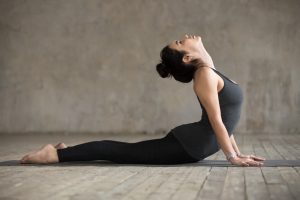
5 Stretches and Exercises for a Herniated Disc
After you get a herniated disc, you may experience pain and limitations in your movement. Fortunately, there are some simple exercises and stretches you can do to help. They can ease the pain, encourage your body to heal, and help you maintain range of motion.
Chin and Neck Stretches
The muscles and tendons in your back and neck are all heavily connected. Doing chin and neck exercises can help to stretch out these muscles and relieve the tension you feel in your back. If you have a herniated disc, such stretches and exercises will help.
The first exercise you can try is the chin tuck exercise. Lay flat on your back with your arms at your side. Tuck your chin in toward your chest until you feel it stretch. Hold the stretch for a few seconds and release. Repeat 15-20 times.
Another exercise to try is the head lift. For this exercise, you will lay on a raised, flat surface (such as a table or firm mattress) on your stomach. Your head should be hanging off the edge of the surface and your arms are at your slides. Raise your head to its neutral position and hold for 10-15 seconds. Release and then repeat 15-20 times or as needed.
Standing Extensions
The standing extension is an exercise designed to help with pain and reduce the pressure on the discs in your spine. To do this exercise, stand up straight and put your hands on your hips. Then extend your hips forward and hold for several seconds. As you push your hips forward, you should be bending slightly backward. Repeat this motion at least 10 times.
Cobra Pose
The cobra pose is a very popular yoga pose. To do it, you begin by laying on your stomach, completely flat on the floor. Place your palms on the floor just below your shoulders and then slowly push upwards. Lift your head and chest up off the ground as far as you can, but don’t push yourself so far that it hurts. This is meant to stretch your back and strengthen your core (which relieves pressure from your back), but you can injure yourself further if you don’t take it slow. Keep in mind that you should be engaging your core, not solely pushing with your arms.
If you wish, you can start off with a variation. Rather than starting on your palms, you can place your forearms on the ground and then lift your body. Doing either variation of this stretch can help you to realign your back.
Standing Row
For the standing row, you will need an exercise band. Begin by securing the exercise band to something stable. Next, stand with your feet hip-width apart. Grasp the band firmly in both hands. While keeping your forearms parallel to the ground, pull the band toward you. Repeat this exercise at least 10 times per set and rest in between sets. Doing this exercise can help to alleviate some of the pain caused by your herniated disc.
Lower Back Exercises
If your herniated disc causes pain in your lower back, you can do a variety of exercises that target this region. Many of these include popular yoga poses. One pose is called the “cat-cow.” In this pose, you begin on your hands and knees. First, you will arch your back upwards (this is the cat portion), and then you curve your back downwards until it appears more like a scoop (this is the cow portion). You repeat this several times to stretch out your back.
Another helpful exercise is the “bird-dog” pose. This pose also begins on your hands and knees. You then lift your left arm and extend it forward while lifting your right leg and extending it straight back. Hold it. Then switch your arms and legs. Repeat as many times as needed. Doing this helps to stretch out and strengthen your back.
These exercises may seem small, but they can make a big difference in the pain you feel and the strength of your back. Try out a few. Whichever stretches and exercises provide you with the most relief, do them consistently. The more you use these exercises and stretches, the better you will feel.
Are you looking for more ways to heal your herniated disc? Click here to explore treatment options at The Nerve & Disc Institute!